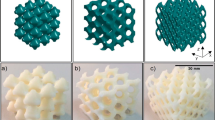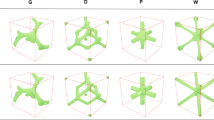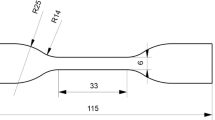Abstract
Triple Periodic Minimal Surface Structures (TPMS) are lightweight scaffolds that are composed of some repetitive cells. This paper is going to be centered in gyroid, diamond and Schwartz Primitive TPMS.
The internal structures of the cells of TPMS are generated thicken a surface that is defined by a mathematical equation. These surfaces have a minimum relationship between the area and the volume and, consequently, their specific mechanical properties and their capability to absorb energy per unit of mass are maximum. However, the mechanical properties of TPMS can vary in each direction; therefore, in certain directions, TPMS have lower mechanical properties that can imply a higher probability that the structure fails in this direction; this would generate a weak point. Thus, this article is going to be centered in the analysis of the anisotropy of the mentioned TPMS.The analysis of the anisotropy is going to be made using N-topology software and different volume fractions are going to be analyzed. Additionally, there is going to be also studied the Zener factor and the anisotropy is going to be graphically plotted. The graphic shape of representation of the anisotropy indicates how the mechanical properties of the TPMS vary depending on the direction. Finally, some specimens have been printed and tested under compression effort according with the ASTM D1621 to obtain the elastic Young’s modulus that have been compared with the numerical ones.
Access provided by Autonomous University of Puebla. Download conference paper PDF
Similar content being viewed by others
Keywords
1 Introduction
Expanded polystyrene foam (EPS) are the traditional material used in most common applications that require to absorb a high quantity of energy and a low weight such as helmets and good envelopes [1]. However, to improve the protection capacity [2], it is essential to use materials with different stiffness depending on the zone that should be protected. i.e.: in the case of a helmet, the stiffness of the head skull is different in each zone and the brain damages and its severity is also different depending on the zone of the brain affected [3]. In the case of EPS, current manufacturing process only allow to generate a constant density material that it is isotropic but it has the same stiffness and energy absorption capability in each zone. Consequently, materials researchers are focused in other materials such as cork and cork agglomerates [4], micellar materials [4] and in the use of additive manufacturing process (AM) to generate materials with different stiffness [5]. Triple periodic minimal surface structures (TPMS) are a type of Lattice structures that offer a maximum capability to absorb energy with a minimum weight [6]. These structures are defined by mathematical functions that define the surface of a unit cell that is reply though the solid. This surface is thicken to transform it into a solid volume. It must be pointed that there are two main parameters that can be customized: the size of the cell unit and the thickness applied to generate a solid structure; the variation of these parameters and the use of one or another material produce material with different mechanical properties that could be easily tailored. It must be pointed, that there are six main different TPMS: gyroid, diamond, split primitive, Schwarz primitive, Lidinoid and Neovious. (see Fig. 1).
In addition, these structures can be generated by AM that allows also modifying their internal properties trough the variation of their internal parameters from one zone to another so this allows to generate structures with different properties depending on the zone that must be protected that is the main method to improve new protective devices. In addition, AM allows to use different TPMS in the same material and to generate structures with parameters that change gradually in function of an equation [7].
However, due to the shape of the surfaces of TPMS structures has a main drawback that is because the generated material is not an isotropic one but an orthotropic. Consequently, there are certain directions in with these structures could fail with a lower load with imply a weak point and should be studied. As a result, it is well-known that some of these structures fails in a certain direction due to buckling process. i.e. diamond structures usually fails trough one of the main diagonals of a brick specimen under compression efforts.[8] Consequently, this article is focused in the study of the anisotropy of some of these TPMS structures.
2 Materials and Methods
Whilst there are six different TPMS structures, this article is focused only in the three that offer most energy absorption capability per unit of weight [9]: gyroid, diamond and Schwartz Primitive that are defined through Eqs. 1, 2, 3:
The study of the anisotropy analyzes the stiffness of a unit cell in each direction and generates a graphic that represent it. Additionally, there are some mechanical properties that can be obtained the elastic modulus in each direction (Ei), the shear modulus (G) and the Poisson’s ratio (ν) and the Zener factor (α).
In the study of the variation of the anisotropy there are certain variables that are not important because the important aspect is how the mechanical properties vary from one direction to another. Thus, it is not important the used material and the cell size. In this study it has been used the mechanical properties of the ASA that is a common material used in AM; it has been defined a cell size of 10 mm.
The study of the anisotropy is made through a numerical homogeneization technique [10]. This method allows to obtain the stiffness matrix of any cubic volume using Finite Elements Method (FEM) numerical tool. The process implies the generation of the surface CAD model of a unit cell of a cubic volume (the length of the size of the solid is not important), the thicken of TPMS structure, the mesh of the volume and the application of different load cases (it is not important the magnitude of the load) to determine the response of the structure under different loads (traction/compression in each direction, pure shear, etc. This allow to determine the elasticity matrix (\({C}_{ij}^{T})\) (using the applied forces in each load case and the response of the structure in terms of deformation) that could be inverted to determine the stiffness matrix (\({S}_{ij}^{T})\). Different analysis [11, 12] have revealed that diamond and gyroid structures are symmetric triple rotational and, consequently \({C}_{ij}^{T}\) has only seven independent elastic constants. However, Schwarz Primitive is symmetrically cubic so it has only 3 (Eq. 4). It must be pointed that the numerical results have revealed that diamond and gyroid are also symmetrically cubic. C11 is the longitudinal stiffness under traction/compression longitudinal efforts, C12 is the transversal stiffness under traction/compression longitudinal efforts and C44 is the stiffness under strain efforts.

Then, the main properties in each direction (i;they are equal for each main direction) like the Young’s Elastic modulus (Ei), the shear modulus (G), the Poisson’s ratio (ν) and the shear coefficient (τ) could be obtained (Eqs. 5, 6, 7, 8):
In the same way, it can be obtained the Zener ratio (α), that is an index that indicates the anisotropy of a material/structure. Values near to 1 indicate a low anisotropy and values far indicate high anisotropy and it is defined by Eq. 9:
N-Topology has been the selected software to generate TPMS CAD specimens, to generate FEM mesh and to prepare and run all the load case to calculate obtain the elasticity matrix and the stiffness matrix. In the same way, this software allows also using these matrixes to obtain the Zener factor.
It was previously mentioned that TPMS properties could be tailored via different ways: changing the solid material used and changing the internal parameters of the structure. However, if the solid material used to generate TPMS is homogeneous and isotropic, this do not have influence in the anisotropy because the variations of the properties in each direction would be similar. In the same way, the size of the unit cell only changes the resultant properties in each direction but the relationship between them would be the same. Thus, there is only one parameters that has influence in the anisotropy that is the thickness of the structure. In this point, it must be highlighted that, for TPMS structures, instead of using the thickness to define the structure, it is usually used the volume fraction (ρ*), that is the relationship between the density of the solid material (ρsolid) and the density of the obtained structure (ρTPMS) (Eq. 10). This parameter possibility to compare different types of TPMS structures and with different unit cell size that, for the same weight per unit of volume have different thickness. It has been analyzed five different volume fraction: 10, 20, 30, 40 and 50%.
It must be pointed that it has been used for the numerical simulation a cubic cell unit of 10 mm of size. It has been used ASA whose mechanical properties (density: 1050 kg/m3, elastic Young’s modulus: 1726 MPa and Poisson’s ratio: 0.4) were determined previously using experimental test and the UNE-EN-ISO 527–1:2012 and a bone AM specimen (see Fig. 2). Additionally, some diamond structures (20, 30 and 40% volume fraction) have been tested under compression efforts according with the ASTM D1621 to obtain the stress-strain curve that has been used to determine the elastic Young’s modulus and to compare them with the numerical ones to validate numerical models. It has been used an 8032 INSTRON uniaxial testing machine that records force and displacement; additionally, a laser extensometer was also used to determine strain. It has been used a velocity of 4 mm/min to avoid strain rate influence. These specimens have been printed using a LEON 3D 3D printer and a LEON 3D ASA material with a 0.4 mm nozzle and the standard parameters of the printer for this material.
3 Results and Discussion
The analysis of the elasticity matrix (see Fig. 3) shows a linear relationship between these properties and the volume fraction with a R2 higher than 0.98. It can be observed also that Schwarz-P structure has the highest elastic constants and, as a result, for the same effort it would deform more. However, there are not significant differences in the values. It can also be observed that C12 and C44 vary with the same slope.
The analysis of the different mechanical properties (see Fig. 4) indicate main mechanical properties increase linearly with the volume fraction and there is a linear relationship with a high R2. The elastic Young’s modulus is higher for diamond structures for low volume fraction but lower for high volume fraction. In the case of Schwarz-P occurs the opposite and the gyroid is always between them.
Gyroid and diamond have a similar shear modulus with a similar slope but Schwarz-P has a higher coefficient that imply higher shear efforts. The analysis of the Poisson’s ratio shows that diamond structure has a constant coefficient (around 0.27) and, in the case of the other materials this coefficient decrease if volume fraction increases. It must be observed that Schwart-P present high value of this coefficient for small volume fraction what imply higher transversal displacement than other structures under the same longitudinal efforts. He analysis of the shear coefficient indicates that approximately all have the same slope and there are small differences among them.
The analysis of the Zener factor (Fig. 5) shows that, whilst gyroid structures present low anisotropy for any volume fraction, diamond structure presents a bit higher one for low volume fraction and Schwarz-P present a significantly higher. There is a tendency for all these structures to reach a value of 1 for high volume fractions.
It is also possible to plot the anisotropy of these materials (see Table 1) using the method proposed by Nye [13]. These figures show the relationship between the stiffness in each direction. Those materials that have low anisotropy acquire a sphere shape but those with high anisotropy have sharp shapes. The analysis shows that, while gyroid structure has a low anisotropy for any volume fraction, Schwarz-P and Diamond have high anisotropy for low volume fraction and tend to the adquire sphere shapes when volume fraction increase. It can be observed that Diamond-P has high protuberances in the main direction that indicate a higher stiffness in the X-Y-Z directions of the material and lower ones in the transversal ones. In the case of Schwart-P, the protuberances appear in the corners so this indicate highest stiffness in the diagonal direction and lowest in the X-Y-Z ones. Hence, gyroid would have the same behavior independently of the direction of the load but diamond would deform more in case of a load in the diagonal direction and the Schwartz-P in the case of a load in the X-Y-Z directions.
The experimental test have revealed that all the specimens follow the Ashby-Gibson model [14] with an initial elastic zone, afterwards a plateau and finally a densification zone with an exponential shape of the curve (see Fig. 6). The slope of the curve in the elastic zone determines the elastic Young’s modulus that is compared in Table 2 with numerical ones. It can be observed small deviation of numerical and experimental results.

4 Conclusions
The main conclusions obtained of this article is that N-Topology is an excellent tool to analyze anisotropy in TPMS lattice structures and obtain results that are near the experimental ones. It must be pointed that gyroid structures present low anisotropy that is reflected in low Zener factors for any volume fraction and the plot of the anisotropy show a sphere shape that indicate this behavior. In the case of the Schwartz-P structure, for low volume fraction, the Zener factors are higher than one that indicate that structure has a higher stiffness in the diagonal directions that is also shown in the graphic plots of the anisotropy. In the case of the diamond, these structure has lower stiffness in the X-Y-Z directions for low volume fraction that match with Zener ratio lower than 1. Consequently, gyroid structure are the best structure to avoid possible undesirable failure modes and in those cases in which the direction of the loads is not sufficiently defined of if it could be in any direction.
Next research lines would be the analysis of the anisotropy of the other types of TPMS structures as well as the experimental analysis of each type of TPMS under different types of efforts used in the homogenization process with different loads to compare the numerical and experimental results. Additionally, it would also necessary to analyze possible local bucklings and how them influence in the global anisotropy. Thus, dynamic non-lineal complex numerical analysis would be essential as well as the development of subroutines for the material model that include different failure modes.
References
Zouzias, D., De Bruyne, G., Miralbes, R., Ivens, J.: Characterization of the tensile behavior of expanded polystyrene foam as a function of density and strain rate. Adv. Eng. Mater. 22(12), 1–15 (2020)
Blanco, D.H., Cernicchi, A., Galvanetto, U.: Design of an innovative optimized motorcycle helmet. Proceedings of the Institution of Mechanical Engineers, Part P: J. Sports Eng. Technol. 228, 95–110 (2014)
Pang, T.Y., et al.: Head and neck responses in oblique motorcycle helmet impacts: a novel laboratory test method. Int. J. Crashworthiness 16, 297–307 (2011)
Jones, M., Mautner, A., Luenco, S., Bismarck, A., John, S.: Engineered mycelium composite construction materials from fungal biorefineries: a critical review. Material Design. 187, 1–25 (2020)
Higuera, S., Miralbes, R., Ranz, D.: Mechanical properties and energy–absorption capabilities of thermoplastic sheet gyroid structures. Mech. Adv. Mater. Struct. 1, 1–15 (2021)
McKown, S., et al.: The quasi-static and blast loading response of lattice structures. Int. J. Impact Eng 35, 795–810 (2008)
Al-Ketan, O., Lee, D.-W., Rowshan, R., Abu Al-Rub, R.K.: Functionally graded and multi-morphology sheet TPMS lattices: design, manufacturing, and mechanical properties. J. Mech. Behav. Biomed. Mater. 102, 1–17 (2020)
Ahmadi, S.M., et al.: Mechanical behavior of regular open-cell porous biomaterials made of diamond lattice unit cells. J. Mech. Behav. Biomed. Mater. 34, 106–115 (2014)
Miralbes, R., Ranz, D., Pascual, F.J., Zouzias, D., Maza, M.: Characterization of additively manufactured triply periodic minimal surface structures under compressive loading. Mech. Adv. Mater. Struct. 29(13), 1–15 (2020)
Steven, G.P.: Homogenization of multicomponent composite orthotropic materials using FEA. Commun. Numer. Methods Eng. 13, 517–531 (1997)
Maskery, I., Ashcroft, I.A.: The deformation and elastic anisotropy of a new gyroid-based honeycomb made by laser sintering. Addit. Manuf. 36, 1–18 (2020)
Maskery, I., et al.: Insights into the mechanical properties of several triply periodic minimal surface lattice structures made by polymer additive manufacturing. Polymer 152, 62–71 (2018)
Nye, J.F.: Physical Properties of Crystals: Their Representation by Tensors and Matrices, 2nd edn. Oxford University Press, Oxford (1986)
Gibson, L.J., Ashby, M.F.: Cellular Solids: Structure and Properties, 3rd edn. Cambridge University Press, Cambridge (1997)
Author information
Authors and Affiliations
Corresponding author
Editor information
Editors and Affiliations
Rights and permissions
Copyright information
© 2023 The Author(s), under exclusive license to Springer Nature Switzerland AG
About this paper
Cite this paper
Miralbes, R., Santamaria, N., Ranz, D., Gómez, J.A. (2023). Study of the Anisotropy of Triple Periodic Minimal Surface Structures Generate by Additive Manufacturing. In: Gerbino, S., Lanzotti, A., Martorelli, M., Mirálbes Buil, R., Rizzi, C., Roucoules, L. (eds) Advances on Mechanics, Design Engineering and Manufacturing IV. JCM 2022. Lecture Notes in Mechanical Engineering. Springer, Cham. https://doi.org/10.1007/978-3-031-15928-2_79
Download citation
DOI: https://doi.org/10.1007/978-3-031-15928-2_79
Published:
Publisher Name: Springer, Cham
Print ISBN: 978-3-031-15927-5
Online ISBN: 978-3-031-15928-2
eBook Packages: EngineeringEngineering (R0)










